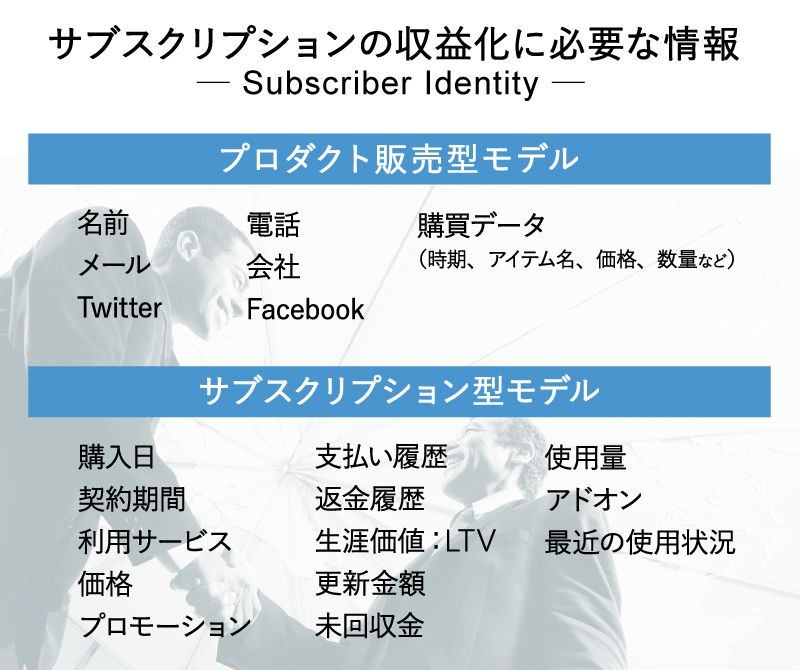Note: This website was automatically translated, so some terms or nuances may not be completely accurate.
Three Essential Perspectives for Introducing a Subscription-Based Business Model
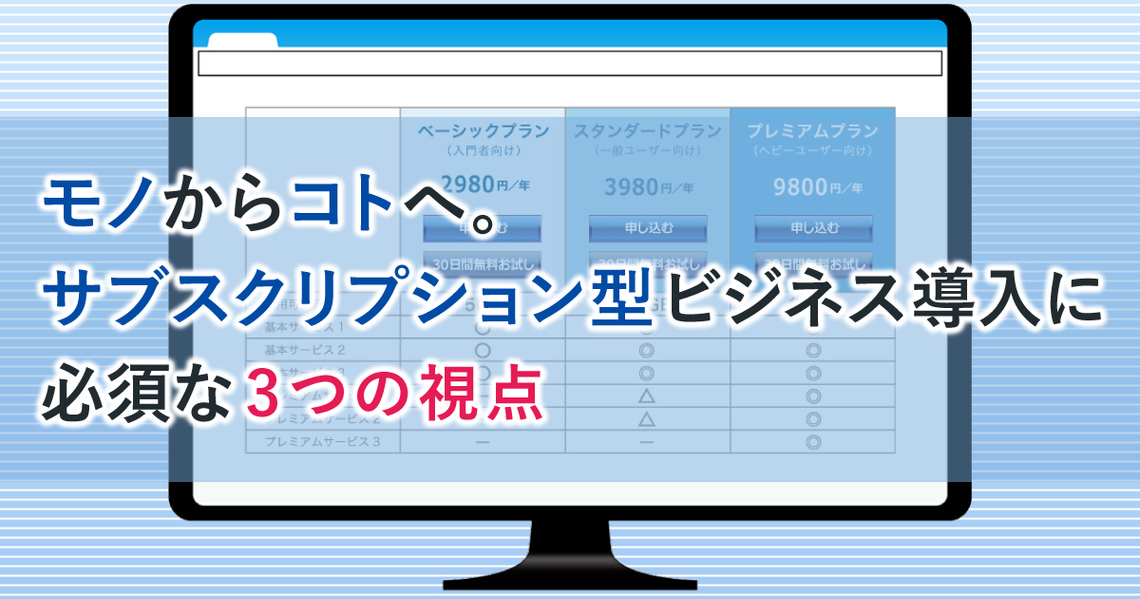
【Table of Contents】
▼From Things to Experiences, from Ownership to Usage: How to Respond to Shifting Consumer Values
▼Three Essential Perspectives for Implementation
▼ Perspective 1: What is Service Design that Exceeds User Expectations?
▼ Perspective 2: How to Acquire Customers?
▼Perspective 3: How to Increase Customer Value?
▼Three Steps for Implementation
-Step 1: User-Centric Service Design
-Step 2: Implementing Systems Supporting Flexible Pricing
-Step 3: Operating Customer Communication Based on Usage Data
▼Subscription Business Implementation Support Provided by Dentsu Group
From things to experiences, from ownership to usage. How to respond to changing consumer values
More companies are shifting from the "product sales model"—selling goods or services to customers for one-time ownership—to the recurring-revenue "subscription-based business model."
■What is a Subscription-Based Business?
・A business model providing ongoing billing (selling usage rights).
・Characterized by offering multiple "plans" (combinations of price and content) and allowing users to freely and flexibly change plans.
■Benefits of Adopting Subscription-Based Business Models
・Achieve optimal marketing by building ongoing relationships through data sharing and mutual communication with users on digital platforms.
・Prevent user inactivity and churn by proposing optimal plan content and timing based on usage patterns and needs.
・Expect stable revenue from a customer base as user retention increases.
・Offering multiple plans, including free trials, facilitates acquiring new users. Subscription-based business models, closely intertwined with digital marketing, represent a new business model optimized for an era where consumers and businesses are constantly connected digitally.
Consumer values are also undergoing a shift in consciousness, moving from "ownership" to "usage." For more on this background, please refer to this article.
This time, the author—who supports corporate business and marketing transformation and digitalization at Dentsu Digital Inc.—introduces the "3 Perspectives" and "3 Implementation Steps" necessary for introducing a subscription-based business.
We will also explain what Zuora Japan and Dentsu Inc., who have partnered to support the implementation of this model for companies, can offer clients.
Three Essential Perspectives for Implementation
Implementing a subscription-based business requires a marketing perspective. Here, we explain three crucial "perspectives."
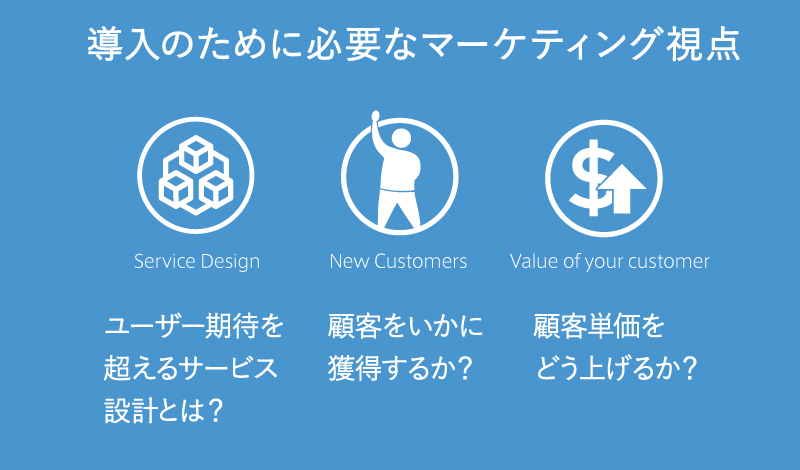
Perspective 1: What is service design that exceeds user expectations?
→ Deliver value only possible through ongoing customer relationships!
When introducing a subscription-based business, it is essential that the newly introduced service offers benefits and appeal to customers.
Since this model relies on maintaining customer connections online, design services that leverage "unique customer benefits only possible through a customer base (i.e., ongoing relationship) model. "
The following two examples utilize the Zuora platform (discussed later) and both represent services made possible precisely because of the "ongoing relationship."
[Example 1] "SURF AIR" – Monthly flat-rate (unlimited flight) service for aircraft

This exemplifies service design responding to the shift from "ownership" to "usage." Instead of purchasing a single-use ticket, passengers pay a fixed amount for unlimited access to commercial flights.
For frequent flyers, this is cheaper than using regular airlines and simplifies the cumbersome check-in process. With a dedicated concierge, it offers a luxury experience akin to a private jet.
This service precisely targets the preferences and needs of the executive class.
[Example 2] Komatsu's " Smart Construction " Service for Construction Machinery

【KOMATSU】Smart Construction Introduction Site
http://smartconstruction.komatsu/
This ICT solution from Komatsu, a global comprehensive machinery manufacturer operating in construction and mining equipment, forklifts, and industrial machinery, targets customers involved in construction sites.
Smart Construction acquires all information generated at construction sites, such as 3D terrain data, and utilizes it throughout the entire construction process. By creating data-driven construction plans, managing progress, proposing optimal construction methods, and controlling construction machinery via ICT, it enhances safety and productivity while shortening project timelines and reducing costs.
This suite of services goes beyond traditional construction machinery sales and rental, offering customers a comprehensive, ICT-driven service package via a subscription model.
It is gaining attention and adoption as a new solution addressing the critical issues plaguing Japanese construction sites: the shortage of skilled workers and labor shortages.
Perspective 2: How to Acquire Customers?
→ Create a "chooseable" format with abundant plans (pricing/content)
In subscription-based business, the focus is not only on acquiring customers but also on "sustaining" the relationship (i.e., the usage contract) with acquired customers. Essential to this is offering a variety of plans and multiple choices.
For example, prepare pricing models like a low-cost or free "Low-Price Plan," an affordable "Basic Plan," and a "High-Price Plan" for heavy users.

Unlike product sales with a single price point, subscription models trigger initial sign-ups by offering service content and pricing variations that allow each customer to choose the best fit for them.
Furthermore, leveraging the constant connection with customers, we can proactively suggest "plan changes" based on their usage patterns. The ease and speed of making these changes directly contribute to contract retention.
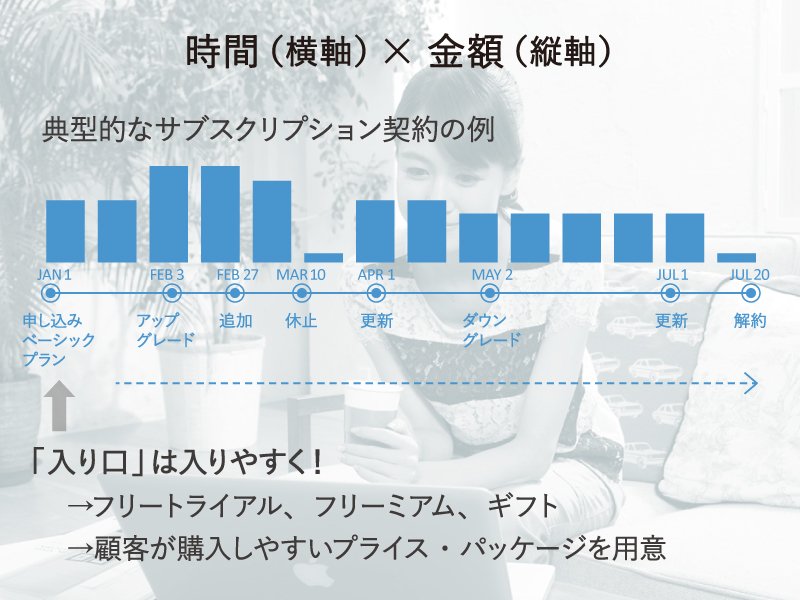
Perspective 3: How to increase customer value?
→ Enhance LTV by strengthening customer engagement
In subscription-based business models, customer value is generally managed through "LTV" (Life Time Value).
To maximize LTV per customer, marketing initiatives focus on "preventing churn/continuing contracts" and "plan upgrades."
The foundation of these measures is "communication based on understanding the customer's situation and needs."
[Examples of LTV Improvement Measures]
・Capture and recommend "needs for additional services" predicted from customer usage patterns
・Proactively suggest upsells, and sometimes downsells, based on usage patterns and estimates
・Provide real-time incentives tailored to individual usage patterns
These measures strengthen customer engagement, directly leading to extended contract periods and increased revenue.
To understand customer situations and needs, real-time data linked to individual customers is essential, such as:
【Examples of Customer Data to Track】
"When did this customer start using which services, and how are they using them?"
"How has usage changed compared to last week?"
"How are they responding to each promotional initiative?"
Zuora refers to these customer data sets as "Subscriber Identity" and advocates acquiring and utilizing them as key to business success.
Three Steps to Implementation
The concept of "enhancing customer engagement to increase revenue" is an approach focused on selling services, not just products. It's a business model applicable across all industries and business types, from building new services to transforming and strengthening existing businesses.
Let's examine the steps for a product-selling company to adopt a subscription-based business model.
Positioned as the steps to realize the "three perspectives" mentioned earlier, they are as follows:
- What is service design that meets user expectations?
→ Step 1: User-Centric Service Design
- How to acquire customers?
→ Step 2: Implementing a system supporting flexible pricing
- How to increase average customer spend?
→Step 3: Implement customer communication based on usage data
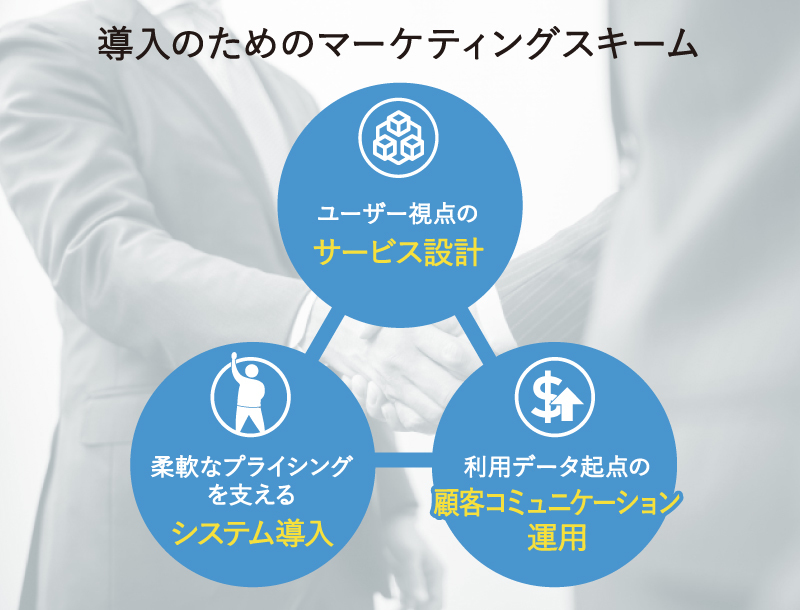
Step 1: User-Centric Service Design
When developing services attached to our products or enhancing existing services, consider the following two points.
[Service Design Fundamentals]
・Will users continue using it?
・Can usage data be captured in some form?
To create services that generate new value or encourage continued use, it is essential to capture not only "customer needs before product purchase" but also "new needs or frustrations that emerge through usage after purchase."
This requires a broad marketing perspective—extending beyond your own products to consider value propositions encompassing the surrounding ecosystem and building them as services.
【Example of a User-Centric Marketing Framework】
・Data acquisition to understand each customer's product/service usage in real time
・Organizational structure and operational processes enabling immediate outreach based on acquired customer data
・1-to-1 marketing and marketing automation enabling immediate outreach
・Real-time dashboards
Step 2: Implementing Systems Supporting Flexible Pricing
Shifting billing and accounting processes from traditional "one-time sales" to "recurring billing" models, or maintaining both in parallel, often requires significant system investments and operational process changes.
Furthermore, achieving the ability to "quickly prepare new plans based on usage data aligned with customer trends" incurs significant human resource costs.
Zuora's Subscription Relationship Management (SRM) platform solves these challenges.
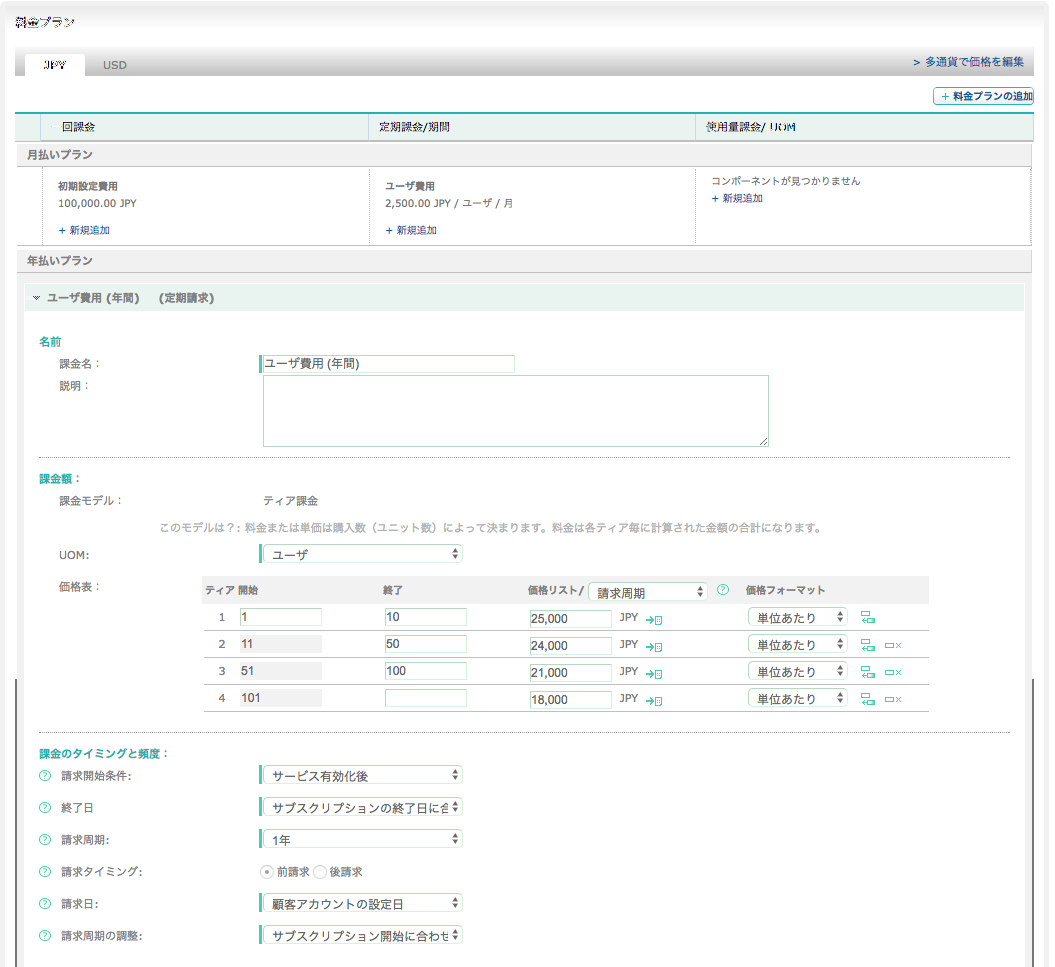
With SRM, even marketing personnel without specialized IT knowledge can create new pricing packages in just minutes by simply selecting conditions for multiple configuration items.
It can integrate with your accounting system or MA tools, combine with 1-to-1 or segment-based customer management to quickly modify pricing packages, propose new plans or send discount coupons to individual customers, and offer tailored payment method options.
Step 3: Customer Communication Operations Based on Usage Data
Continuously communicate with customers from initial contract acquisition, accumulate and analyze each response, and feed it back into the scenario. Building an operational framework, including PDCA, is the final step.
In subscription-based businesses, communication focused on "retaining and nurturing existing customers" is crucial. While many examples already exist in the e-commerce space, companies selling products may have fewer examples of implementing "real-time communication by segment" leveraging Subscriber Identity tied to existing customers.
Use customer satisfaction metrics and NPS (Net Promoter Score, an indicator of customer loyalty) to gauge engagement.
Then, to maintain and enhance positive relationships, provide customers with beneficial information and proposals.
To achieve this, you need to anticipate customer needs by analyzing past usage patterns and predicting future behavior using data from similar customers. This requires preparing multiple communication scenarios that deliver thoughtful, "omotenashi"-style service that anticipates customer needs.
Subscription Business Implementation Support Provided by the Dentsu Group
Dentsu Inc. and Dentsu Digital Inc. have launched a service to provide comprehensive support for the steps involved in introducing a subscription-based business model through a business partnership with Zuora Japan. We work alongside clients to address challenges across all areas of their business, offering integrated support.
Specifically, we provide extensive support ranging from Zuora SRM implementation assistance, planning leveraging the Dentsu Group's strength in uncovering customer insights, business process design, to post-launch communication operations.

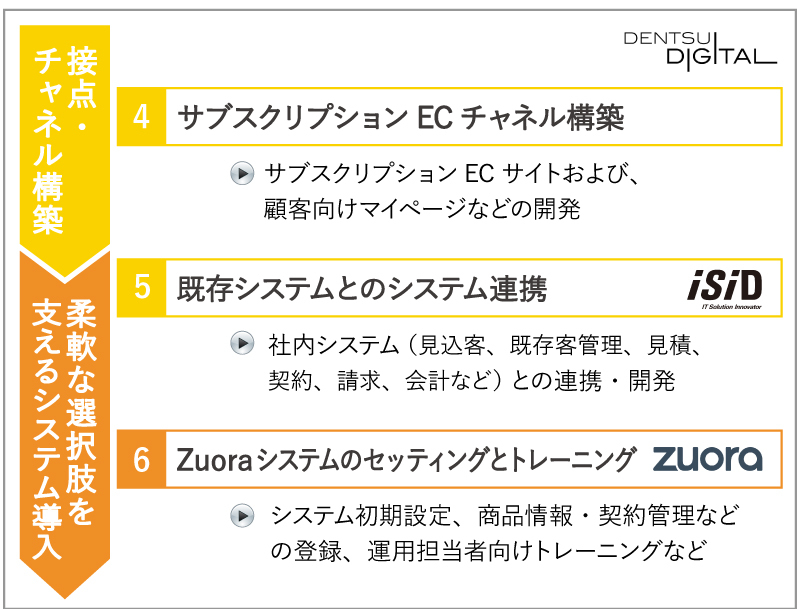
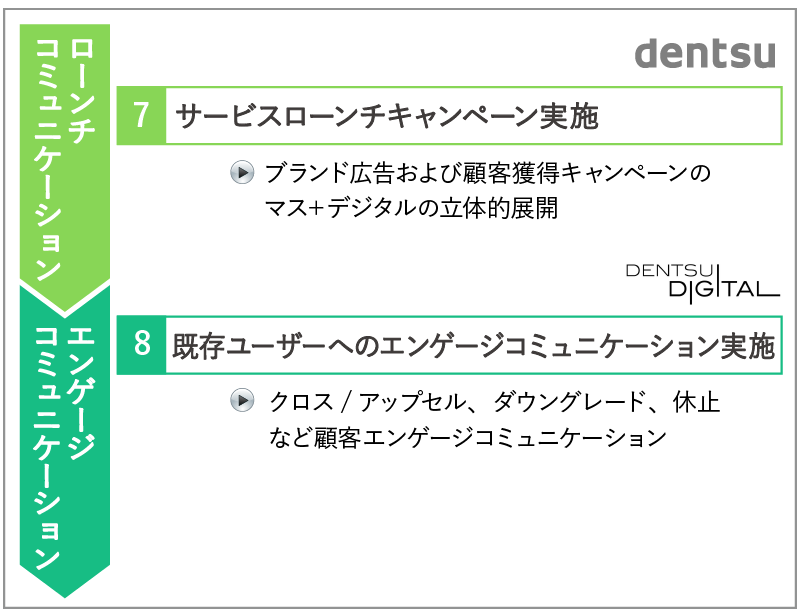
Services Provided by Dentsu Inc. and Dentsu Digital Inc.
■ Business Process Design and Development Support for Businesses/Services
Support for planning, strategy formulation, and business process design/development for clients' new subscription-based businesses and services.
■Touchpoint/Channel Construction Support
Creation of e-commerce sites, customer management systems, and customer portals for communication.
Support for introducing tools and system integration for customer management and communication linked to existing systems. SRM implementation, configuration, and initial training.
■Communication Operations Support
Planning, designing, and operating launch communications for initial customer acquisition.
Creating scenarios for ongoing customer communication, supporting PDCA cycles, and providing continuous operational support.
Not only companies considering shifting to a subscription-based business model, but also those thinking, "We want to leverage our existing customer data" or "We're exploring new business opportunities" – we encourage you to consider what kind of business you could develop using your own products and services.
※Unauthorized reproduction of images within this article is prohibited. For details, please refer to the Web Dentsu Inc. Terms of Use ( https://dentsu-ho.com/terms/ ).
Was this article helpful?
Newsletter registration is here
We select and publish important news every day
For inquiries about this article
Back Numbers
Author

Yuki Toyama
Dentsu Digital Inc.
Business Transformation Division Service Innovation Department
Division Manager
Marketing/Accounts: Engaged in planning operations across diverse industries including soft drinks, IT/AV/home appliances, entertainment services/content, and finance. Provides comprehensive consulting from product/brand development to strategy formulation and communication initiatives. Currently at Dentsu Digital Inc., focusing primarily on distribution and finance, supporting the service transformation of businesses through digital shift, as well as the development and growth of new businesses and services.
